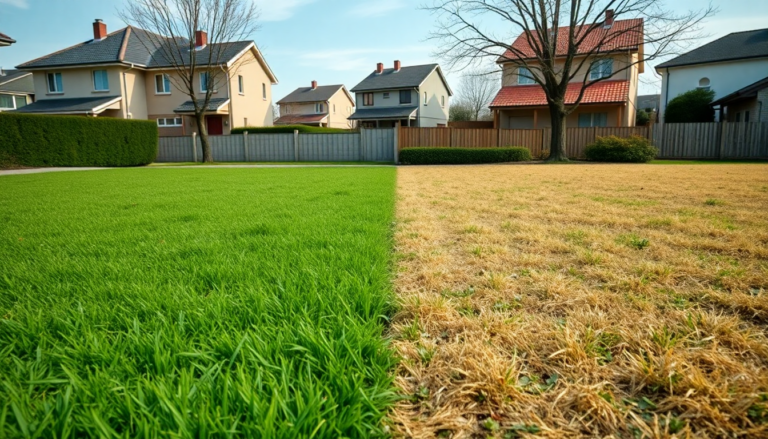Argomenti trattati
Have you ever stood on your porch, gazing across the street, and felt a twinge of envy as you compare your lawn to your neighbor’s? Perhaps their grass is a lush green, while yours seems patchy and sad. It’s a familiar feeling for many homeowners, and while you may think it’s all in your head, it often isn’t. Multiple factors can influence your lawn’s health and appearance, as experts in turf management often highlight. But before you dive headfirst into costly renovations or exhaustive care routines, let’s get real about what you can do—and what is simply beyond your control.
Understanding grass types and regional conditions
It might surprise you to learn that the secret to your neighbor’s vibrant lawn could lie in the type of grass they have planted. Different grass varieties thrive in varying climates and soil conditions. For instance, warm-season grasses flourish in sunny, warm climates, while cool-season grasses prefer cooler temperatures and do best in the spring and fall. If your lawn is struggling, it might simply be that your neighbor has a grass type better suited to your local conditions.
Now, what can you do about it? Well, if you’re stuck with an existing lawn, a full renovation can be expensive. However, consulting your local university extension service can provide valuable insights. They can help you identify the grass species you have, which is a crucial first step in tailoring your lawn care routine. Just keep in mind that while they can pinpoint the type of grass, they may not identify the exact variety—some are just naturally more resilient than others.
Cutting and mowing techniques
Have you been guilty of mowing your lawn too short? I remember a time when I thought I could achieve that perfect golf course look by scalping my grass. What a mistake! Cutting grass too short exposes the stems and leaves behind unsightly brown patches. It also means fewer blades to photosynthesize, which ultimately weakens your lawn. Instead, consider mowing based on the grass’s growth rate rather than a strict weekly schedule. For instance, during the spring, when growth is vigorous, you might need to mow twice a week. In contrast, during dry spells in summer, you might only need to mow every few weeks.
And let’s not forget about those clumps of grass left behind after mowing. If you’re noticing piles of clippings, your mower might be struggling with the height of the grass. When that happens, simply raise the mower deck to avoid unsightly clumps, ensuring a cleaner cut.
Weed management and herbicide timing
Seeing an abundance of weeds, even after you’ve treated your lawn, can be incredibly frustrating. Timing is everything when it comes to weed control. Using a pre-emergent herbicide too late can allow weeds to take root before you can stop them. It’s essential to monitor soil temperatures, as many weeds, like crabgrass, start germinating around 55 degrees Fahrenheit. So, getting your treatments down at the right time is crucial for effective weed management.
Watering wisely
Setting a timer for irrigation may seem like a smart choice, but it often fails to consider the unique environmental factors affecting your lawn. With fluctuating weather conditions—like heat and humidity—your lawn may not need daily watering. Overwatering not only wastes resources but can also lead to shallow root systems. Instead, water your lawn when it truly needs it. Signs like bluish grass, wilting blades, or footprints that linger in the turf indicate it’s time for a good soak. Watering in the early morning hours can minimize evaporation, making it the most efficient time for irrigation.
Blade sharpness and mowing effects
Ever noticed your grass looking ragged after mowing? A dull mower blade can tear grass rather than cut it cleanly, leading to an uneven appearance. To maintain a well-groomed look, ensure your mower blades are sharpened regularly—this can be done at a local small engine shop. A sharp blade will make all the difference in achieving that crisp, manicured look.
Addressing difficult areas
If there’s a spot in your yard that just doesn’t seem to thrive, it might be time to reassess. Some areas may be too shady for grass to grow well, while others may endure heavy foot traffic. If you have a high-traffic area, think about replacing that grass with something sturdier, like ground cover or even paver stones. It might not be the lush lawn you envisioned, but it could create a more functional space.
The importance of soil aeration
Soil health is vital for a thriving lawn. Compacted soil limits oxygen accessibility to grass roots, stifling growth. Aeration helps remedy this by creating openings in the soil, allowing roots to breathe. Not every lawn requires annual aeration, but if you have heavy traffic or dense soil, every few years might be ideal. Hiring a professional for core aeration is usually more effective than DIY methods, which can sometimes compress the soil further instead of aerating it.
Managing pet damage
Pet owners can relate—those brown patches left by dog urine can be disheartening. It’s the high concentration of salts in pet urine that causes the grass to burn. Contrary to popular belief, there’s no miracle remedy that can prevent these spots. However, one effective approach is to water the area immediately after your pet does their business. This can dilute the salts and help prevent severe damage. Alternatively, retraining your pet to use a less visible area can save you from the unsightly patches.
Ultimately, remember that a perfect lawn is a lofty goal—perhaps unattainable for most of us. But with a little understanding and a few adjustments to your care routine, you can significantly enhance the look of your yard. And who knows, maybe you’ll even inspire some neighborly envy!

